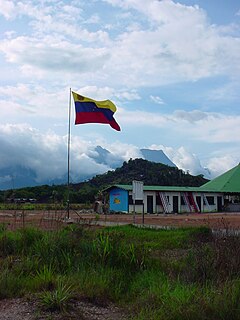
Charles Gaudichaud-Beaupré was a French botanist.
Soejatmia is a monotypic genus of flowering plants belonging to the family Poaceae. It just contains one species, Soejatmia ridleyi(Gamble) K.M.Wong

Heliamphora tatei is a species of marsh pitcher plant endemic to Cerro Duida, Cerro Huachamacari and Cerro Marahuaca in Venezuela. It is closely related to H. macdonaldae, H. neblinae, and H. parva, and all three have in the past been considered forms or varieties of H. tatei. Like H. tatei, these species are noted for their stem-forming growth habit.
Julian Alfred Steyermark was an American botanist. His focus was on New World vegetation, and he specialized in the family Rubiaceae.
Leiboldia is a genus of flowering plants belonging the family Asteraceae. It is also in the tribe Vernonieae.

Cerro Duida, also known as Cerro Yennamadi, is a very large tepui in Amazonas state, Venezuela. It has an uneven and heavily inclined plateau, rising from highs of around 1,300–1,400 metres (4,300–4,600 ft) in the north and east to a maximum of 2,358 metres (7,736 ft) on its southwestern rim. It has a summit area of 1,089 km2 (420 sq mi) and an estimated slope area of 715 km2 (276 sq mi). At its foot lies the small settlement of La Esmeralda, from which the mountain can be climbed.

Swinglea is a monotypic genus of flowering plants belonging to the family Rutaceae. It only contains a single species, Swinglea glutinosa.
Steyermarkia is a monotypic genus of flowering plants belonging to the family Rubiaceae. It only contains one known species, Steyermarkia guatemalensisStandl.

Humbertia is a monotypic genus of flowering plants belonging to the family Convolvulaceae. It only contains one species, Humbertia madagascariensisLam. It is native to Madagascar.
Irlbachia is a genus of flowering plants belonging to the family Gentianaceae.
Macbrideina is a monotypic genus of flowering plants belonging to the family Rubiaceae. It only contains one known species, Macbrideina peruvianaStandl.
Neobrittonia is a monotypic genus of flowering plants belonging to the family Malvaceae. It only contains one known species, Neobrittonia acerifolia
Neomortonia is a monotypic genus of flowering plants belonging to the family Gesneriaceae. It just contains one species, Neomortonia roseaWiehler
Raveniopsis is a genus of flowering plants belonging to the family Rutaceae.
Sandemania is a monotypic genus of flowering plants belonging to the family Melastomataceae. The only known species is Sandemania hoehnei.
Hartleya is a monotypic genus of flowering plants belonging to the family Stemonuraceae. The only species is Hartleya inopinata.
Killipia is a genus of flowering plants belonging to the family Melastomataceae. It is now a 'synonym' of MiconiaRuiz & Pav..
Krukoviella is a monotypic genus of flowering plants belonging to the family Ochnaceae. It has one synonym PlanchonellaTiegh. The only species is Krukoviella disticha(Tiegh.) Dwyer
Merrittia is a monotypic genus of flowering plants belonging to the family Asteraceae. The only species is Merrittia benguetensisMerr.
Ochoterenaea is a monotypic genus of flowering plants belonging to the family Anacardiaceae. The only species is Ochoterenaea colombiana.




